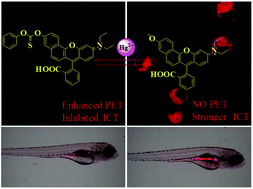A carbonothioate-based far-red fluorescent probe for the specific detection of mercury ions in living cells and zebrafish†
Abstract
The detection of ionic mercury (Hg2+) is very important because it is a highly toxic environmental pollutant that could cause serious diseases and threaten human health. Herein, we designed a new carbonothioate-based far-red fluorescent probe, CBRB, with a seminaphthorhodafluor dye as the fluorophore for the detection of Hg2+. The CBRB probe by itself exhibited very weak fluorescence due to the enhanced photo-induced electron transfer (PET) effect and inhibited the intramolecular charge transfer (ICT) process caused by the carbonothioate moiety. Upon addition of Hg2+, a tremendous fluorescence enhancement was achieved, attributed to the removal of the carbonothioate group via a specific mercury-promoted desulfurization reaction. Moreover, the probe displayed a large Stokes shift (about 105 nm) and was used to quantitatively measure the concentration of Hg2+ for concentrations ranging from 0 to 1 μM (DL = 3.6 nM). In addition, CBRB in our experiments responded exclusively to Hg2+, even in the presence of high concentrations other ions. Gratifyingly, this probe was successfully used to monitor Hg2+ in environmental water samples and to image Hg2+ in living cells as well as in zebrafish.

- This article is part of the themed collections: In celebration of Chinese New Year 2020 and Recent analytical chemistry science from China


 Please wait while we load your content...
Please wait while we load your content...